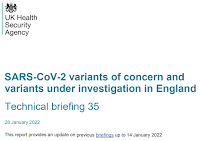#16,536
While the Omicron subvariant BA.2 is getting a lot of press, we still don't know a whole lot about this new entry in the pandemic sweepstakes, although it appears to be outperforming the BA.1 Omicron varant in several Northern European nations (see here, here, and here).Yesterday, Denmark's SSI characterized the transmission of BA.2 as being `well over one and a half more contagious than BA.1.', and a week ago the UK Health Security Agency designated BA.2 as a Variant Under Investigation (VUI).
Still unknown are the relative severity of BA.2 compared to BA.1, and whether recent infection with BA.1 conveys protection against subsequent infection with BA.2. Both are factors that could weigh heavily on the future impact of this new subvariant.
While a month ago, Omicron BA.1 was being touted as one of the most transmissible viruses in the world. Today, it appears that BA.2 has once again upped the ante.
Today the UKHSA released two documents describing what is known about BA.2. First stop, an excerpt from the 28-page report:
SARS-CoV-2 variants of concern andvariants under investigation in England
Technical briefing 35
28 January 2022
(EXCERPT)
BA.2 The Omicron variant sub-lineage BA.2 was designated a variant under investigation (VUI22JAN-01) by the UK Health Security Agency (UKHSA) Variant Technical Group on 19 January 2022. As of 24 January 2022, 1,072 genomically confirmed cases of BA.2 have been identified in England. This is a small number of cases for characterisation analysis and BA.2 assessments are therefore preliminary.
Sequencing data is complete up to 16 January, at which point 96.1% of sequences were BA.1, 3.4% were BA.2 and 0.5% were other lineages. BA.2 does not contain the deletion at S:69-70 and is S-gene target positive (SGTP) on PCR diagnostic assays with targets in this area. SGTP is now a reasonable proxy for BA.2 (accounting for 80% of sequenced SGTP cases with an increasing trend).
The proportion of SGTP cases is now increasing. As of the 24 January 2022, the overall proportion of SGTP cases in England is 4.4% compared to 2.2% on the 17 January. There is geographical variation with the highest proportion in London (9.5%) and the lowest in the North-East region (0.9%).
Growth rate
BA.2 has an increased growth rate compared to BA.1 in all regions of England where there are sufficient cases present to make an assessment. Whilst growth rates can be overestimates early in the emergence of a variant, the apparent growth advantage is currently substantial.
Secondary attack rates
Analysis from routine contact tracing data indicated higher secondary attack rates amongst contacts of BA.2 cases in households (13.4%; 95% CI: 10.7%-16.8%) than those for contacts of other Omicron cases (10.3%; 95% CI: 10.1%-10.4%) in the period 27 December 2021 to 11 January 2022. These secondary attack rates are not adjusted for vaccination status and reflect overall growth advantage rather than transmissibility.
Vaccine effectiveness
A preliminary assessment did not find evidence of a difference in vaccine effectiveness against symptomatic disease for BA.2 compared to BA.1. However, numbers included in this study are relatively small and it will be iterated. The University of Oxford has reported preliminary unpublished pseudovirus neutralisation data. In this study, BA.1 and BA.2 pseudoviruses did not differ substantially in neutralisation by sera from vaccinated individuals.
The UKHSA also released the following risk assessment graphic, which only cites to to moderate confidence in the data (and insufficient data on severity), but suggests BA.2 has a transmission advantage over BA.1.

Places - such as the United States - where Omicron appears to have peaked, may see another wave of cases later this spring. Its size will likely depend upon the duration and strength of resistance following BA.1 infection.
If BA.2's severity remains on par with - or is less - than we saw with BA.1, then this should be manageable. So far, we don't have enough data to say with confidence one way or the other.
For countries like China - which have managed to control community transmission of the pandemic virus through aggressive `Zero-COVID' policies - that task is likely to become even harder to maintain.
And without high levels of community immunity left over from prior waves, BA.2's impact may prove greater.
Despite bland assurances by many governments that we are nearing the `end' of the pandemic, SARS-CoV-2 continues to deliver new, often game-changing variants with frustrating regularity.
An evolutionary process that could easily continue for quite some time.
